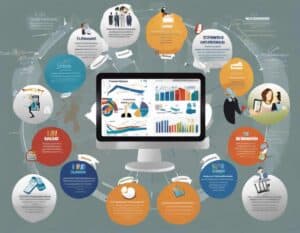Negotiation is key in sales, and active listening is one of the most effective tools a salesperson can use.
Active listening means fully focusing, understanding, responding to, and remembering what’s said in a conversation. Let’s check out how this helps sales professionals get better results.
- Key Takeaways:
- Engaging in active listening during a sales negotiation helps build trust with the customer, showing that you are genuinely interested in their needs and concerns.
- By actively listening to the customer, you can gain valuable insights into their pain points, preferences, and priorities, which can help you tailor your sales pitch accordingly.
- Active listening fosters better communication and understanding between you and the customer, leading to more effective and successful sales negotiations.
- Listening attentively to customers’ concerns and opinions demonstrates respect and empathy, which can help you build stronger and long-lasting relationships with them.
- Active listening can help you identify and address any conflicts or objections raised by the customer during the negotiation process, allowing you to find mutually beneficial solutions.
Understanding Active Listening
Active listening is a strategic communication technique that involves fully concentrating, understanding, responding, and remembering what is being said. It is a skill that goes beyond simply hearing the words spoken by the other party.
Active listening requires the listener to be fully present in the moment and engage with the speaker to comprehend their message accurately.
Empathy plays a crucial role in active listening as it allows the listener to not only understand the words being spoken but also to grasp the emotions and perspectives behind them.
By empathizing with the speaker, the listener can build trust and rapport, which are imperative components of successful sales negotiations.
The Benefits of Active Listening in Sales
Active listening is a powerful skill in sales that can significantly enhance the outcomes of negotiations.
By truly engaging with clients, sales professionals can build stronger relationships and foster an environment conducive to successful deals. Let’s delve into these benefits of active listening in sales.
- Enhances Trust: Clients feel valued and respected, fostering trust that is crucial for long-term relationships.
- Improves Rapport: Active listening helps build a strong rapport, making clients more comfortable during negotiations.
- Increases Client Satisfaction: When clients feel heard, they are more satisfied with the service and the negotiation process.
- Facilitates Better Understanding: Sales professionals can better understand clients’ needs and concerns, leading to more tailored solutions.
- Encourages Openness: Clients are more likely to share critical information, providing insights that can guide the negotiation.
- Identifies Opportunities: By listening actively, salespeople can spot opportunities for mutual benefits and more favorable deals.
- Reduces Conflicts: Understanding client perspectives through active listening can help in preempting and resolving potential conflicts.
- Secures Repeat Business: Strong relationships built on effective communication encourage clients to return for future business.
Incorporating active listening into sales strategies not only enhances client interactions but also drives better business outcomes, making it an indispensable skill in the field of sales.
Active Listening Techniques for Sales Professionals
Active listening is a key component of successful sales negotiations, enabling professionals to connect deeply with clients and understand their needs.
By mastering various techniques, sales professionals can enhance their communication skills and drive better outcomes. Here are some techniques for effective active listening in sales.
1. Mastering the Art of the Pause
This involves intentionally stopping to let the other person speak without interruptions.
This practice gives the speaker space to express themselves fully, often revealing more than they initially intended. To effectively master the art of the pause, consider these steps.
- Pause Before Responding: Wait a few seconds after the client finishes speaking to ensure they have completed their thought.
- Encourage Continuation: Use non-verbal cues like nodding to indicate you’re listening and want them to continue.
- Avoid Filling Silence: Resist the urge to fill quiet moments; let the client break the silence.
- Reflect Before Speaking: Use the pause to reflect on what’s been said before formulating your response.
- Invite More Input: Occasionally ask if there’s anything more the client would like to add.
This technique demonstrates respect and patience, encouraging clients to share openly. It creates an environment where clients feel their contributions are valued, leading to more meaningful interactions.
2. Asking Open-Ended Questions
This technique involves posing questions that require more than a yes or no answer.
Open-ended questions encourage clients to elaborate on their thoughts, providing deeper insights into their needs and motivations.
To ask open-ended questions effectively, follow these guidelines.
- Start with ‘How’ or ‘Why’: These starters prompt more detailed responses.
- Avoid Leading Questions: Phrase your questions neutrally to get unbiased information.
- Follow Up for Clarity: If an answer is vague, ask for specific examples or further explanation.
- Encourage Storytelling: Invite clients to share experiences or scenarios related to their needs.
- Summarize and Confirm: Echo what you’ve heard to ensure you’ve understood correctly.
This approach helps uncover the client’s true needs and priorities. It fosters a dialogue that builds trust and makes the client feel heard and understood.
3. Reading Non-Verbal Cues
This involves observing and interpreting the client’s body language, facial expressions, and tone of voice.
Non-verbal cues can reveal unspoken thoughts and emotions, providing context to the words being said. Enhance your ability to read non-verbal cues with these actions.
- Maintain Eye Contact: Show attentiveness and respect by looking at the speaker.
- Observe Body Language: Note posture, gestures, and expressions to gauge comfort and interest levels.
- Listen to Tone of Voice: Changes in pitch or speed can indicate underlying feelings.
- Mirror Positively: Subtly mimic the client’s positive gestures to build rapport.
- Ask About Discrepancies: If body language seems at odds with words, gently inquire for clarification.
Understanding these cues helps discern the full message, including any reservations or enthusiasm not expressed verbally. It enables sales professionals to respond more empathetically and effectively.
4. Reflecting and Clarifying
This involves repeating or paraphrasing what the client has said to show understanding; clarifying ensures there are no misunderstandings.
This technique confirms the listener’s comprehension and can uncover any areas of confusion.
To reflect and clarify effectively, use these strategies.
- Paraphrase Key Points: Summarize the client’s words in your own to show you’ve understood.
- Ask for Clarification: If unsure, request more details or examples.
- Use Reflective Questions: Pose questions that prompt the client to explain further.
- Acknowledge Emotions: Recognize and validate any feelings the client expresses.
- Confirm Agreements: Reiterate agreed points to ensure mutual understanding.
This practice ensures accurate communication and builds a foundation of trust. It helps prevent misunderstandings and strengthens the relationship between the salesperson and the client.
5. Active Summarization
This involves periodically recapping the discussion to keep both parties aligned on key points.
Summarizing helps both the salesperson and the client stay focused and confirms that all important points have been addressed. Implement active summarization with these techniques.
- Summarize at Intervals: Break down the conversation into segments and summarize after each major point.
- Highlight Agreements and Action Items: Clearly state what has been agreed upon and the next steps.
- Encourage Feedback on Summaries: Ask the client if your summary captures everything accurately.
- Use Visual Aids: If possible, note key points on paper or digitally for visual reference.
- End with a Comprehensive Recap: Conclude meetings with a full summary to reinforce understanding and agreements.
This technique ensures nothing is missed and that both parties are in agreement on what has been discussed. It provides a clear path forward and reinforces the effectiveness of the entire negotiation process.

Final Thoughts | Unlock the Secrets of Sales Success with Active Listening
Active listening is the key to unlocking successful sales negotiations. By tuning in attentively to the needs and concerns of their clients, sales professionals can build strong rapport, uncover essential insights, and devise solutions that benefit everyone involved.
This strategic approach ensures fruitful negotiations and cements lasting relationships based on mutual trust and understanding.
If you’re looking to enhance your sales game and stay ahead in the competitive landscape, invest in tech-advanced sales management software.
Together, we can elevate your skills and strategies to new heights.




















